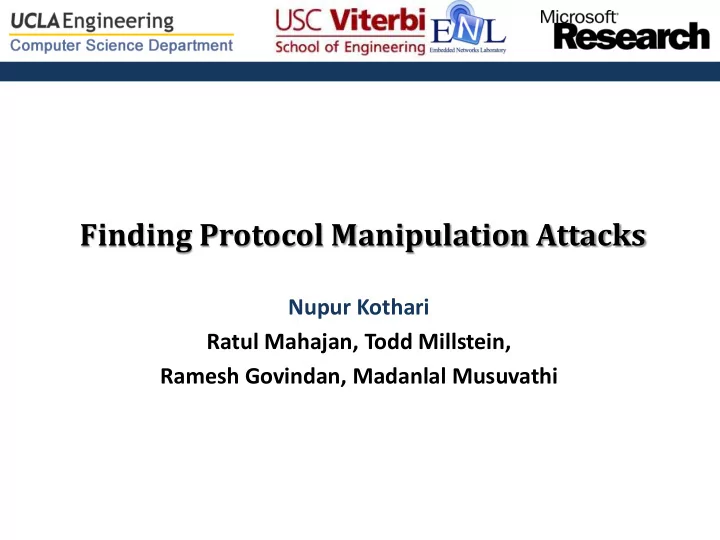

Finding Protocol Manipulation Attacks Nupur Kothari Ratul Mahajan, Todd Millstein, Ramesh Govindan, Madanlal Musuvathi
Manipulation Attacks Adversaries induce victim into undesirable behavior by lying in their messages • Exploit partial information among participants • Hard to detect because messages are protocol- compliant
Example: Optimistic ACKs in TCP [Savage ‘01] Regular TCP Optimistic ACKs TCP Sender TCP Receiver TCP Sender TCP Receiver Receiver pretends packets are received earlier than they are Sender fooled into sending data faster
Other Examples ECN (Explicit Congestion Notification) [Ely ’01] • Adversarial receiver hides congestion by resetting the congestion bit in ACK Sender is fooled into ignoring congestion 802.11 MAC (WiFi) [Bellardo ‘03] • Adversary sets high duration value in data frames Neighboring nodes are starved
Goal and Contributions Goal Automate finding manipulation attacks in protocol implementations Contributions Novel use of program analysis techniques to find manipulation attacks • Guided by developer inputs MAX: A tool to analyze C protocol implementations • Finds all known attacks in TCP, 802.11 and ECN, and a new variant in SCTP
Manipulation Attack Characteristics Lying: Adversaries induce victim into exhibiting undesirable behaviors by modifying messages Protocol-compliance: Messages are valid under other conditions Repetition: Manipulations may need to be repeated to have significant impact
Finding Manipulation Attacks: Challenge Manipulations triggering undesirable behavior All possible packet manipulations Manipulation Extremely Large! Attacks Can be repeated All Different Different possible protocol network message conditions states headers
Our Approach: Static + Dynamic Analysis User Inputs Vulnerable statement(s) Network setup, Impact Symbolic execution Metric(s) Statically computes conditions under which a code path is taken Path constraints Messages that lead to vulnerable statement(s) given current victim state Adversarial concrete execution Manipulation attack Emulate adversarial behavior during protocol execution Sequence of manipulations to repeatedly trigger vulnerable statement(s)
MAX: Symbolic Execution Vulnerable Feasible Code Paths Statement(s) Path Constraints seq == rcv_next rcv_established (…) packets_out-- ack_seq <= snd_nxt ack (…) ack_seq >= snd_una1 clean_rtx_queue (…) tp->packets_out-- Challenges Scalability: Prune uninteresting parts, work on partial programs Accuracy: Use domain-specific knowledge to improve approximations for pointers, type-casts
MAX: Adversarial Concrete Execution Victim snd_nxt = 4323 Victim ….. State ack_seq Modified 4323 Messages Feasible Code Paths Adversarial Module Path Constraints ack_seq Intercepted Messages 2815 seq == rcv_next Network ack_seq <= snd_nxt ack_seq >= snd_una1 Adversary
MAX: Outputs Set ack_seq to snd_nxt for all Sequence of incoming ACKs manipulations Vulnerable that work Statement(s) MAX Network Setup Comparison between Impact Metric(s) adversarial and honest execution
MAX Implementation Uses CIL framework for C Uses Z3 constraint solver Can analyze real protocol implementations (user-level) or simulator code
MAX Evaluation Protocol Protocol Protocol Protocol Protocol LoC (K) LoC (K) LoC (K) LoC (K) LoC (K) Attacks Found Attacks Found Attacks Found Attacks Found Attacks Found 14.2 14.2 14.2 14.2 TCP (Daytona) Optimistic ACKing TCP (Daytona) TCP (Daytona) TCP (Daytona) Optimistic ACKing Optimistic ACKing Optimistic ACKing Optimistic ACKing Optimistic ACKing Optimistic ACKing 12.5 12.5 12.5 SCTP SCTP SCTP variant variant variant 802.11 MAC 802.11 MAC 11.0 11.0 NAV, RTS NAV, RTS (Qualnet) (Qualnet) 7.6 ECN Echo ECN (Qualnet)
Exploring TCP with MAX Daytona • User-level port of Linux 2.2 kernel TCP Vulnerable Statement: Decrease the number of outstanding packets at the TCP Sender Network Setup: same LAN, background TCP traffic Congestion TCP Sender TCP Receiver
Exploring TCP: Optimistic ACK Attack MAX manipulates the sequence number ACKed to last sequence number sent out by receiver • Successfully causes vulnerable statement to be executed ACKed Sequence Number TCP Throughput Increased Sequence Number Successful manipulation attack! No satisfying paths found
Exploring SCTP with MAX: Take 1 Experimental setup identical to TCP Vulnerable Statement: Decrease the number of outstanding packets at the SCTP Sender MAX increases cumulative TSN ACKed TSN (Seq. No.) ACKed SCTP Throughput Failed manipulation attack! Rate of change of TSN ACK decreased Sudden drop in throughput
Why the attack failed Sending rate depends on outstanding packets and receiver window • # of packets for which the receiver currently has space Subtle difference between TCP and SCTP receiver window semantics • Decreasing outstanding packets does not capture the difference in semantics Receiver window ACKed Sequence No. ACKed Sequence No. TCP Sender TCP Receiver SCTP Sender SCTP Receiver Receiver Receiver window window
Exploring SCTP with MAX: Take 2 New Vulnerable Statement: sending messages MAX manipulates TSN ACKed and receiver window size TSN (Seq. No.) ACKed SCTP Throughput Successful manipulation attack!
Summary and future work Novel approach to find manipulation attacks in network protocol implementations • Found known attacks in TCP, 802.11, and ECN, and a new variant in SCTP Future work • Study other protocols and attacks • Mitigate manipulation attacks • Other forms of semantic analysis of protocols enl.usc.edu/projects/max
Recommend
More recommend